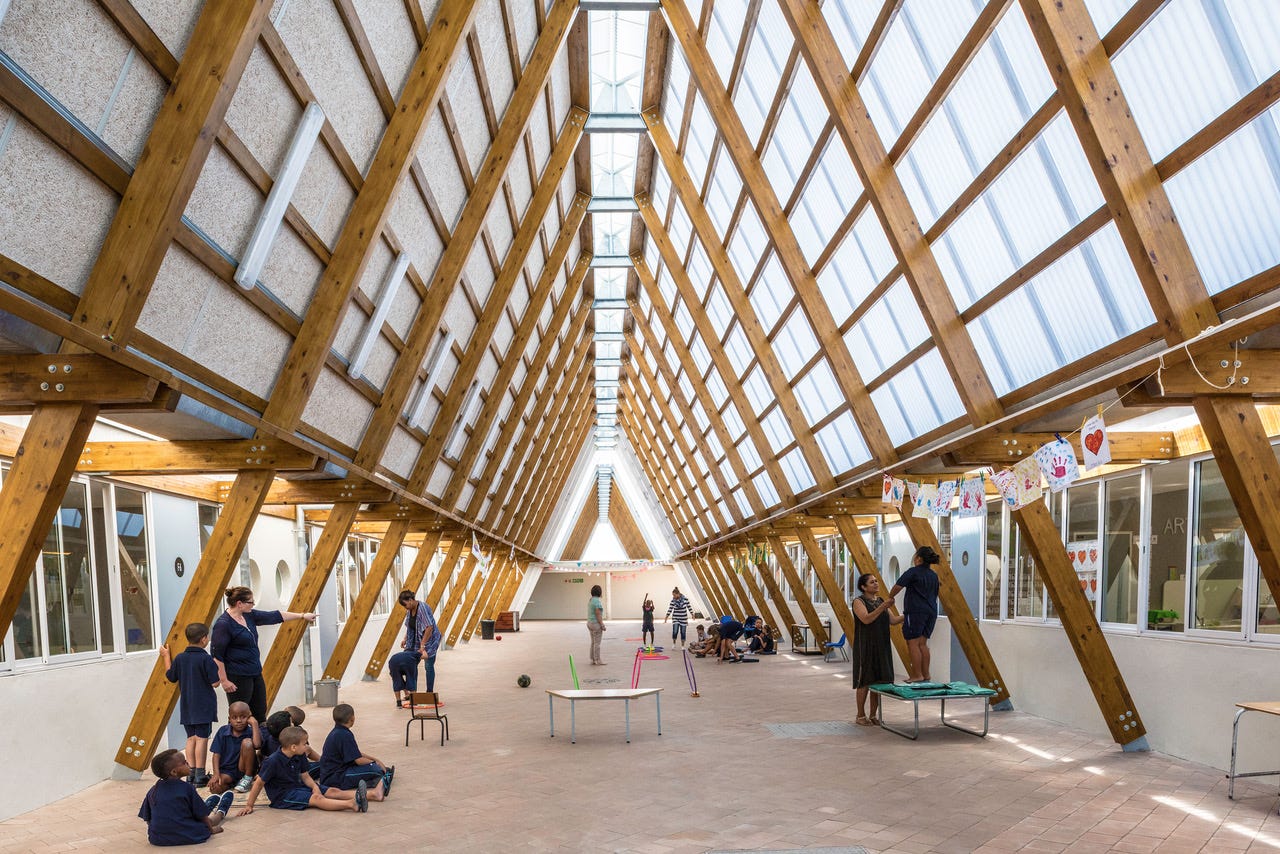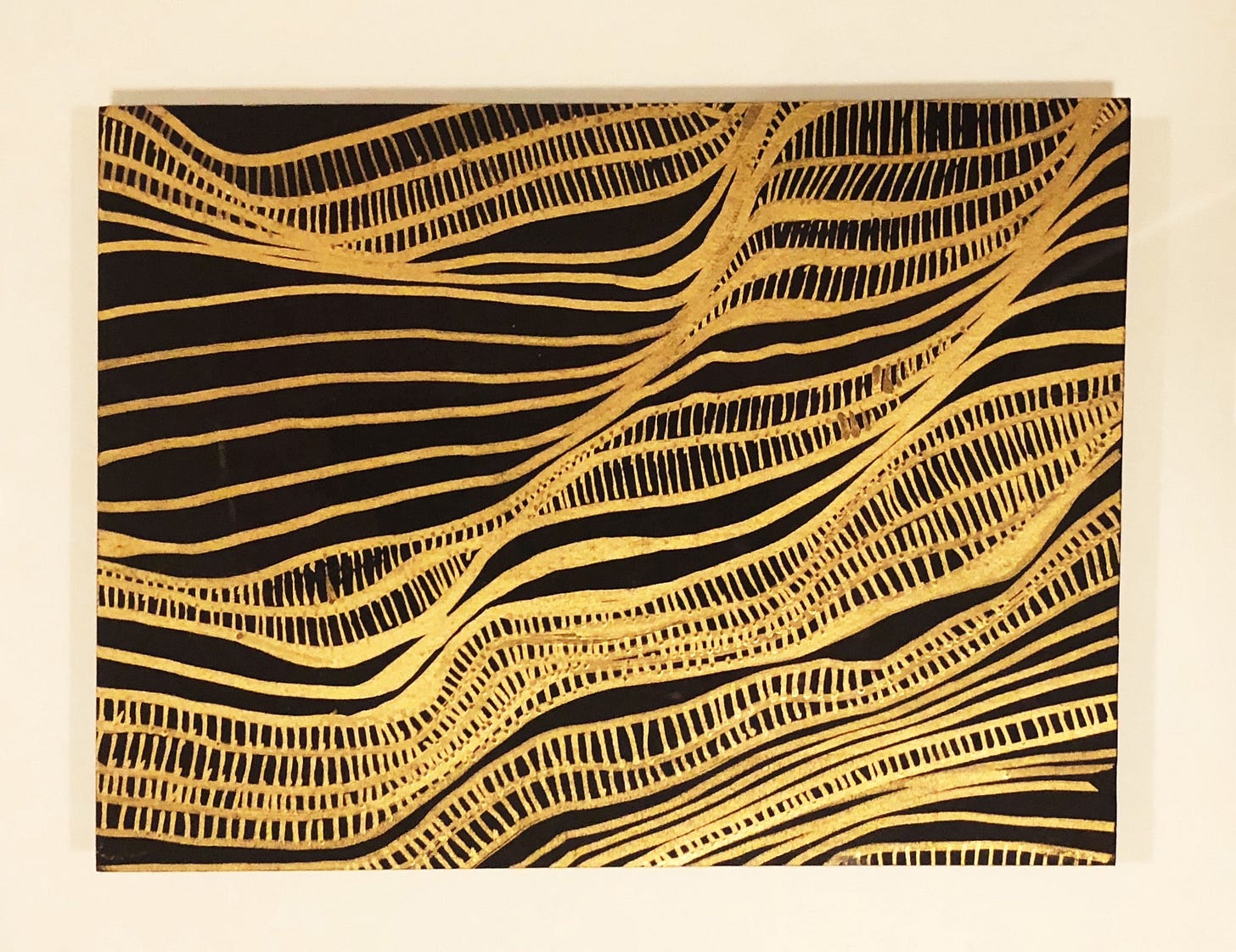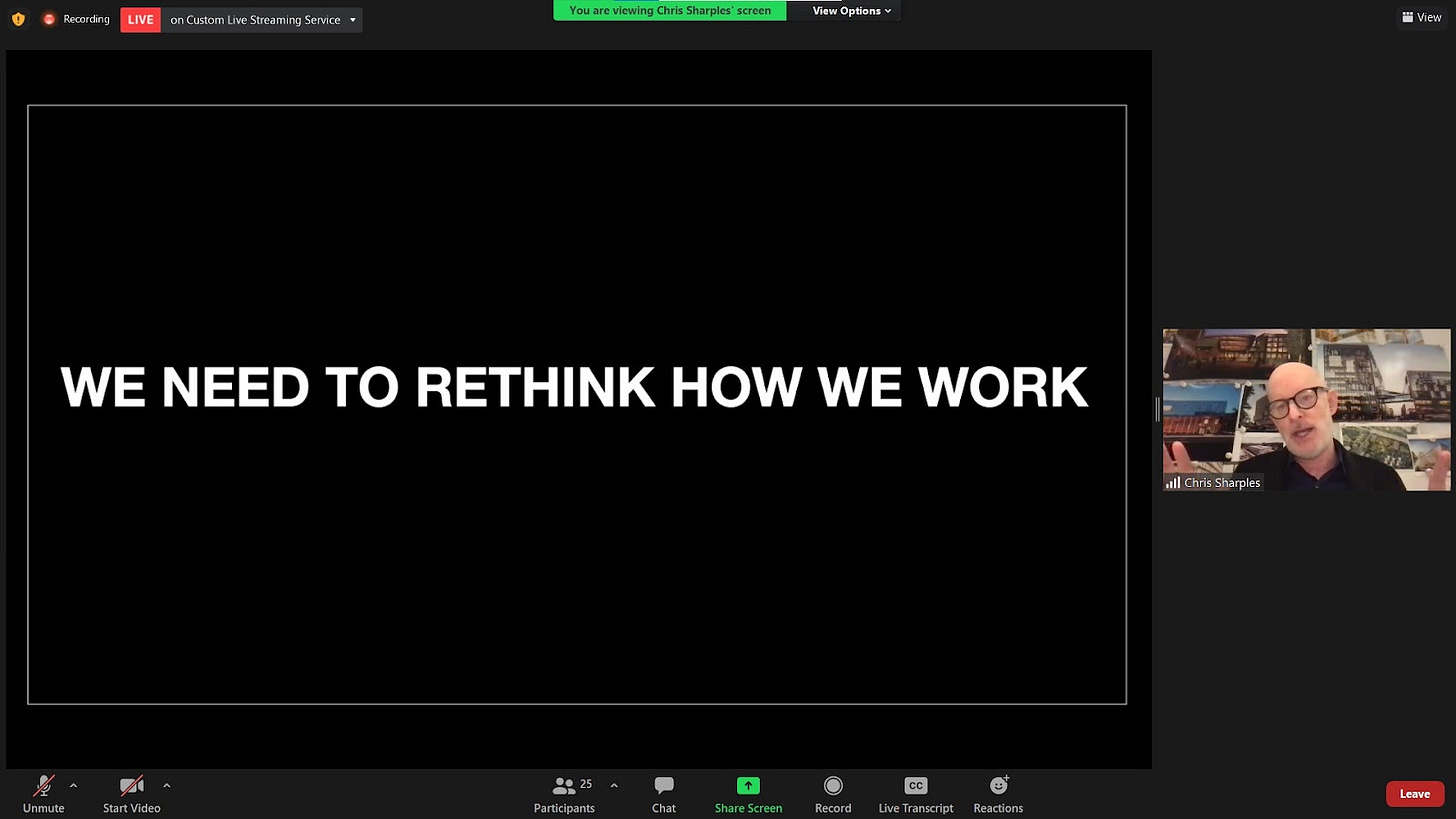S K Y L I N E | SHoP Cofounder Chris Sharples points to a brighter future
Also: whither the Corona shack?
Issue 57. If someone forwarded you SKYLINE and you ravenously read it but wish you were not spending so much time on your phone, subscribe and read us in print.
CONTINUING THE SHoP DISCOURSE…
Last Thursday evening, co-founding principal of SHoP Architects CHRISTOPHER SHARPLES presented a lecture to the New York Institute of Technology, titled “Manufacturing Brighter Futures.” Likely organized before the firm’s unionization campaign went public, the mood at times resembled a reunion of 25 friends all gathered on Zoom. The talk covered themes like placemaking and placekeeping, and relevant innovations such as Design for Manufacture and Assembly (DfMA) and Design for Disassembly (DfD). About halfway through the lecture, the tone shifted, turning towards a discussion of how architects need to take responsibility for the way the industry conducts business.
“We love designing buildings, but we’ve got some big problems,” began Sharples. “We’ve got a housing crisis [...] we’ve got a climate crisis that is just accelerating [...] and there is a lot of slavery that goes into construction.”
The way forward, suggested Sharples, is to break down the silos that exist in the AEC industry, and “begin to manage risk collectively and change the value model” through technology and innovation. Digital platforms involving augmented reality, as well as model-based processes, were floated as solutions. “We have to move from a deliverables fee-for-service model to an award based on performance, so that we can actually get proper compensation […] if we can help manage that risk for [the client] in a very transparent and collective way, we should be rewarded for that,” Sharples concluded.
All in all, the big issues were raised, a cause was championed, and solutions were proposed…but the elephant remained in the room.
— Mai Okimoto
About that elephant. We have an excellent new issue all about unions in architecture, and we are sharing a piece from that issue that is making waves on the internet, Organizing-SHoP.
WHAT’S AHEAD
Greetings and salutations, readers.
This issue of SKYLINE boasts an impressive variety of topics: the historic origins of the 21st century’s conference/festival/biennale obsession, a South African architecture firm’s take on subverting Apartheid-era power structures and aesthetics, an artist-architect explains how interpersonal relationships are the mediating element that links her two disparate creative pursuits, and an obituary of sorts for the NYC outdoor dining shed.
There is an abundance of events next week and further into the spring semester. You can find them all towards the end of this newsletter.
Happy reading!
— Anna Gibertini
DISPATCHES
2/10: Crystal Palaces: The London, New York, and Paris World's Fairs, 1851–55
The World's Fairs of the mid-19th century marked the advent of large-scale art, science, and industry showcases that are multitudinous and commonplace across the globe today. Whereas nowadays these types of events—Art Basel, SXSW, the Venice Biennale, just to name a few heavy-hitters—take place across a variety of venues, the first World Fairs were held in palatial greenhouses. “Crystal Palaces: The London, New York, and Paris World’s Fairs, 1851-55,” presented by FRANCIS MORRONE on behalf of the National Arts Club, detailed the impetus behind and construction of these buildings.
In his lecture, Morrone was almost thorough in examining the World’s Fairs held in London (1851), New York City (1853), and Paris (1855). There was one glaring omission: Morrone neglected to acknowledge the colonial violence that procured much of the wares for the host countries’ displays. Still, his stimulating presentation revealed how the zeitgeist of this innovative age manifested in the then-unprecedented technological feat of constructing grand glass buildings in record time.
— Eva Beeman
2/16: Current Work with Wolff Architects

Calling in from their Cape Town studio, ILZE and HEINRICH WOLFF, founders of Wolff Architects, described how their work subverts Apartheid-era power structures and invites occupant-led change over time. “Buildings are more like meals than monuments,” said Heinrich, in urging designers to embrace the inevitable modification of their work by owners and users. The key is to create “a differential of more changeable and more permanent parts,” as seen in Wolff Architects’ recent projects: a cultural center, a school, a puppeteers’ workshop, a hospital, and a start-up office suspended over a market hall, among others. If the Farnsworth House were in South Africa, he added, “It would be sold for scrap” because its design “privileges appearance over inhabitation.” The lecture, co-presented by The Architectural League and The Cooper Union, concluded with a beautifully layered soundscape representing a squatter-occupied Brutalist ruin—originally a community center designed by Uytenbogaardt & Rozendal in the hamlet of Steinkopf—which Ilze called “the ultimate freespace.”
— Gideon Fink Shapiro
2/16: For The Many with Yen Ha

New York-based architect and visual artist YEN HA is often asked how she connects her two modes of creative practice. In a lecture at Rice University, Ha deftly drew the audience into her work as she crafted an answer-in-progress. By showing images of “Invisible Gate”, an outdoor art gallery located in Poland that she worked on as one of three firms that tackled the project independently over 10 years, and “Mailed Art”, a series of handmade postcards sent during New York City’s 2020 COVID-19 lockdown, Ha offered that the link between these practices is her desire to forge connections with people she will likely never meet.
Ha’s embrace of chance encounters and indeterminacy circles back to something one of her favorite professors, Arthur Lubetz, once said. According to Ha, Lubetz believed “Architecture should be incomplete.” Ha takes that idea one step further and suggests that it’s people who complete her architecture and her art.
— Louise Harpman
SO LONG, CORONA SHACKS?
What was it about Streeteries—those outdoor dining structures variously known as Corona Shacks, COVID Shanties, or Pandemitecture—that gave rise to dozens of Instagram accounts and Twitter threads documenting them?
@nyc_food_shanty’s bio describes this social media trend well; it’s an “account dedicated to the appreciation of COVID outdoor dining structures in NYC and preserving their history when they’re gone.” That same appreciation is seen in the photos of @coronashaxx. Generally well composed according to typical architectural photography conventions, the images are shot from frontal or corner, one-point perspectives, absent of people, focusing on the presentation of the built object. Other accounts take the approach of a street photographer, quickly capturing spontaneous compositions of varying quality.
But in that representative bio, appreciation is followed by preservation, and a premonition that these structures in time will disappear from our streetscapes. This instinct to preserve our contemporary moment is what American literary critic Fredric Jameson called a “nostalgia for the present.”
Nothing about the streeteries’ aesthetics or barebones function brought about their documentation. It was their novelty, their status as a typology directly tied to a particular moment in time, that engendered these accounts. They’re prime examples of what social media theorist Nathan Jurgenson, writing in The Social Photo: On Photography and Social Media, calls our “contemporary documentary vision.” This is the embodied vision of social media “encouraging users to take the present as a potential document to be seen by others,” rendering “the ephemeral into something tangible and our life into something collectable, consumable.” @nyc_food_shanty and others like it were mimicking what the restaurant industry was doing in creating streeteries: reacting to fear of an uncertain present and future.
However, these photos aren’t just documentary. They’re social photos, distinguished by “the degree to which [the photo’s] existence as a standalone media object is subordinate to existence as a unit of communication.” Social photos document what’s before the lens, but primarily are created to be shared, and in doing so, communicate the experience of the image maker more than the particularities of image’s content. Mostly anonymous, the streetery accounts do create a kind of nostalgic archive, but only when viewed as individual scenes, arbitrarily collected and ordered by a profile. When viewed in the stream, however, these documents became part of transmitting the collectively—if not equally—experienced transformations in the city under COVID. While no individual account or photograph was particularly notable, the collective phenomenon was—if for no other reason than to mark an experience that soon may disappear from our streets, and soon after our memories.
As the DOT works to formalize the Open Restaurants program, it seems the streetery’s time has come—at least in the forms that we know. These accounts may become nostalgic archives after all; however, what mattered about the accounts was their capacity to witness these changes and to convey them as they were happening, in the stream of life. No need to mourn the streetery, they’ll always be available at the tip of your fingers.
— Nicholas Raap
OPPORTUNITIES
Babyn Yar Holocaust Memorial Center is holding a Masterplan Open Ideas Competition to commemorate the site where, between 1941 and 1943, Nazis shot 70 to 100 thousand people, killing almost the entire Jewish population of Kyiv. The Babyn Yar Holocaust Memorial Center seeks to bring the history of Babyn Yar closer and make it relevant to current and future generations. Up to three winners of the competition will each be awarded US $20,000. Inquiries due on April 15, submission deadline on May 15. To find out more information, please visit the competition website.
Urban Omnibus / The Architectural League of New York and Urban Design Forum are starting a fellowship program to empower new, fearless, and diverse voices to challenge the ways we understand, design, and develop our cities. Fellows will be awarded a stipend of $15,000 for participation in the 18-month fellowship. In addition, they will be provided a travel or research stipend of $2,000 and an allowance of up to $2,500 for project expenses. Deadline is March 23, information session is February 28. Information here.
EYES ON SKYLINE
In Skyline 56, we were all still fixated on the collapse of the unionization effort at SHoP.
IN THE NEWS
…in Los Angeles, Hillside Villa tenants at risk of eviction are organizing to get the city to expropriate their building through eminent domain and remove it from the brutal speculative market…
…Hong-Kong based architect James Law delivered visualizations for crypto-entrepreneur Anthony Welch’s South Pacific “crypto utopia”…
…more than a decade after breaking ground, a celebrity-funded, starchitect-designed post-Katrina housing project in New Orleans gets a fresh wave of headlines for going “horribly wrong”...
…In Yellow Springs, Ohio, Oberer Homes scrapped the affordable portion of its new housing development less than a week after comedian-entrepreneur Dave Chappelle threatened to pull his investments out of the town…
…in Berkeley, California, a NIMBY neighborhood group sees a new victory: the California 1st District Court of Appeal upheld a 2021 ruling ordering UC Berkeley to freeze its enrollment numbers and halt expansion of its housing and academic facilities…
DATELINE
The week ahead…
Friday, 2/18
Cyclical City: Five Stories of Urban Transformation with Jill Desimini and Julie Bargmann
12:00 PM | Harvard GSD
THE INSTITUTION AS REVOLUTION: HOW HIGHER ED CAN LEAD 'SIDE B’S’ OF HISTORIC PRESERVATION with Eduardo Ruas, Taylor Kabeary
1:00 PM | Pratt
Prop Tech Presents: MALLORIE BRODIE
1:00 PM | Columbia GSAPP
Saturday, 2/19
BUILT TO LAST: AN ANTIOXIDANT PERSPECTIVE ON BODIES AND THINGS with Hannah Landecker
12:00 PM | The Cooper Union
Monday, 2/21
Incorporating Practices with Jay Cephas
6:30 PM | Columbia GSAPP
PlanetNow! Panel: Conversations in Environmental Studies Lecture Series with Salmaan Craig, Rafael Beneytez-Durán, Heather Davis
7:00 PM | Rice University
Tuesday, 2/22
A Conversation with A+A+A Architects with Andrea Chiney, Arianna Deane, and Ashley Kuo
7:00 PM | Parsons
Wednesday, 2/23
Towards Another Architecture with Cave_bureau
12:30 PM | The Farrell Centre
Baumer Lecture, The Possibilities of Infrastructure with Nahyun Hwang, David Eugin Moon
5:30 PM | Ohio State University Knowlton School of Architecture
BUILT UP: An Historical Perspective on the Contemporary Principles and Practices of Real Estate Development with Patrice Derrington
6:00 PM | Skyscraper Museum
Mira Tower, Studio Gang with Jeanne Gang
12:30 PM | NYIT
Rice Design Alliance Spotlight Award + Lecture: Nguyen Hai Long and Tran Thi Ngu Ngon
6:30 PM | Rice University
Thursday, 2/24
Womxn in Design and Architecture Conference with June Jordan
12:00 PM | Princeton School of Architecture
Sciame Lecture Series, Radical Black Space: Difference and Design with Justin Garrett Moore
6:00 PM | Spitzer School of Architecture
VISITING LECTURE | THIRTEEN WAYS OF LOOKING with Stella Bets
6:30 PM | The Cooper Union
Modern Eclecticism: Carlo Mollino Architect & Designer with Napoleone Ferrari, Michelangelo Sabatino
6:30 PM | Yale University
LETTERS TO THE EDITOR
Would you like to share your thoughts? Send them on over! Simply reply to this email or write to us at editor@nyra.nyc.
Four desk editors run NYRA: Alex Klimoski, Phillip Denny, Carolyn Bailey & Nicolas Kemper (who also serves as the publisher).
To pitch us an article or ask us a question, write to us at: editor@nyra.nyc.
For their support, we would like to thank the Graham Foundation and our issue sponsors, Tod Williams Billie Tsien Architects and Thomas Phifer.
To support our contributors and receive the Review by post, subscribe here.





